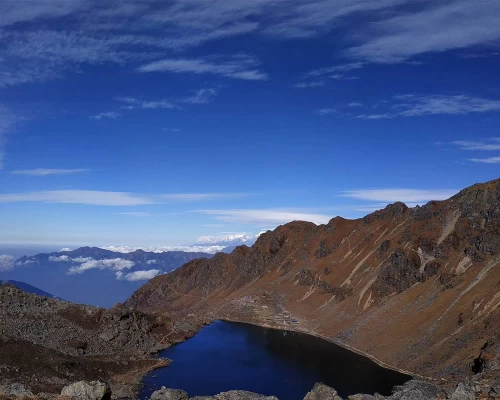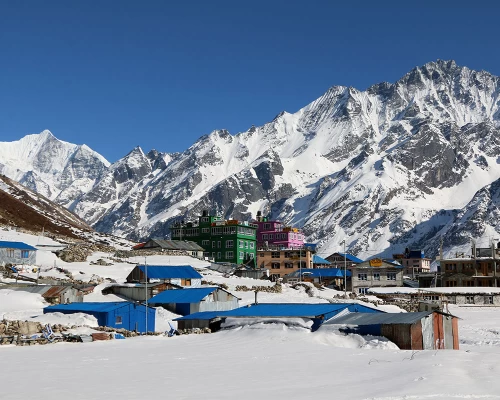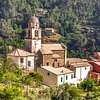Highlights
- Gosaikunda Lake, located at 4,380 meters, is a holy site surrounded by mountains, and you can also see other beautiful lakes like Saraswati Kunda and Bhairav Kunda.
- Trekkers can enjoy amazing views of Langtang Lirung (7,227 meters) and other mountains like Dorje Lakpa, Ganesh Himal, and Yala Peak along the way.
- Kyanjin Gompa, a quiet Buddhist monastery in the Langtang Valley, and other small monasteries on the trail offer peace and stunning mountain views.
- Langtang Village, rebuilt after the 2015 earthquake, is a great place to experience Tamang culture, try local food, and meet friendly villagers.
- Crossing Laurebina Pass at 4,610 meters is challenging but gives incredible views of mountains and the Gosaikunda Lakes below.
- The Helambu region is known for its unique Hyolmo culture, old monasteries, stone houses, and the warm welcome of its people.
- The trek lets you experience Tibetan culture with prayer flags, carved stone walls, and prayer wheels showing the region's spiritual beauty.
Langtang Gosaikunda Helambu Trek Overview
Langtang Gosaikunda Helambu Trek is one of the most popular trekking routes in Nepal. Organized by Himalayan Joy Adventure, this trek combines three amazing areas in the Himalayas, located just north of Kathmandu: the beautiful Langtang Valley, the holy Gosaikunda Lake, and the culturally rich Helambu region.
On this trek, you will get to see Langtang Lirung and other stunning mountains up close. You will also explore the amazing Himalayan landscapes and learn about the Tibetan-influenced culture and traditions of the local people.
One of the main highlights is visiting the holy lake of Gosaikunda, where thousands of Hindu and Buddhist pilgrims come every year, especially during the full moon festival in August. You will also visit the Helambu region, which is known for its unique and colorful culture.
The trek starts in Kathmandu, where you will spend your first night. On the secnd day, you will travel by bus to Syabrubesi, the starting point of the trek.
You will reach Langtang Village and Kyanjin Gompa on the third day of trekking. After spending a day exploring Kyanjin Gompa, you will walk back to Bamboo, a small village near Syabrubesi. Instead of returning to Syabrubesi, you’ll head to Thulo Syabru and continue trekking for two days to reach Gosaikunda.
From Gosaikunda, the trek takes you south through the 4,600-meter Laurebina Pass. After three days, you will arrive in the Helambu region, where you can experience the culture and traditions of the local people. After exploring Helambu, you will trek for two more days and then drive back to Kathmandu.
The trek takes 16 days in total, but it can be adjusted to fit your needs and preferences. If you would like to customize your trek, please let us know, we would be more than happy to plan it for you.
Is it possible to see the Gosaikunda Lake during the trek, and why is it significant?
Yes, it is absolutely possible to see the Gosaikunda Lake during the Langtang Gosaikunda Helambu Trek, as it is one of the main highlights of the journey. Located at an altitude of 4,380 meters, this sacred alpine lake is surrounded by stunning mountain views and rugged landscapes, making it a breathtaking sight for trekkers.
Gosaikunda holds deep religious and cultural significance, especially for Hindus and Buddhists. According to Hindu mythology, the lake was created by Lord Shiva, who struck his trident into the ground to form the lake and drink its water after swallowing poison to save the world. For Buddhists, the lake is also considered holy, and many believe it to be a place of spiritual purification.
Every year, thousands of pilgrims visit Gosaikunda, especially during the full moon festival in August, known as Janai Purnima, to pay their respects and take a holy dip in its waters. The tranquil beauty of the lake, along with its spiritual aura, makes it an unforgettable experience for anyone trekking in the region.
How long does the trek take to complete?
The Langtang Gosaikunda Helambu Trek typically takes around 16 days to complete, including travel time to and from Kathmandu. This duration includes trekking through beautiful valleys, crossing high mountain passes, and exploring cultural villages along the way.
The trek can be adjusted based on your fitness level, schedule, or preferences. For example, if you prefer a faster pace or want to skip certain sections, the itinerary can be shortened. Similarly, you can extend the trek to spend more time exploring places like Kyanjin Gompa, Langtang Valley, or the Helambu region.
No matter the duration, this trek offers an incredible experience of Nepal’s natural beauty and cultural richness. If you would like to customize the length of your trek, feel free to contact us!
What is the difficulty level of this trek?
The Langtang Gosaikunda Helambu Trek is considered a moderate to challenging trek. While it doesn’t require advanced mountaineering skills, it does involve several days of walking on uneven and steep trails, often at high altitudes.
The most challenging part of the trek is crossing the Laurebina Pass at 4,600 meters, where the thin air can make trekking more difficult. Trekkers also need to be prepared for long walking hours, sometimes 5 to 7 hours a day, depending on the itinerary.
This trek is suitable for people with a moderate level of fitness and some prior trekking experience. Beginners can also complete it successfully with proper preparation, such as training, acclimatization, and a steady pace during the trek.
With the right mindset, determination, and the support of guides or porters if needed, the trek is achievable and offers incredible rewards in terms of scenery, culture, and personal accomplishment.










